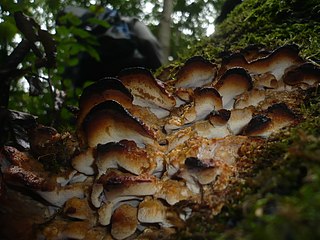
Junghuhnia is a genus of crust fungi in the family Steccherinaceae. It was circumscribed by Czech mycologist August Carl Joseph Corda in 1842. The generic name honours German-Dutch botanist Franz Wilhelm Junghuhn.

Daedaleopsis confragosa, commonly known as the thin walled maze polypore or the blushing bracket, is a species of polypore fungus in the family Polyporaceae. A plant pathogen, it causes a white rot of injured hardwoods, especially willows. The fruit bodies are semicircular and tough, have a concentrically zoned brownish upper surface, and measure up to 20 cm (8 in) in diameter. The whitish underside turns gray-brown as the fruit body ages, but bruises pink or red. It is found all year and is common in northern temperate woodlands of eastern North America, Europe, and Asia. The species was first described from Europe in 1791 as a form of Boletus, and has undergone several changes of genus in its taxonomic history. It acquired its current name when Joseph Schröter transferred it to Daedaleopsis in 1888.

The Meruliaceae are a family of fungi in the order Polyporales. According to a 2008 estimate, the family contains 47 genera and 420 species. As of April 2018, Index Fungorum accepts 645 species in the family.

Postia is a genus of brown rot fungi in the family Fomitopsidaceae.

Cerrena is a genus of poroid fungi in the family Polyporaceae. The genus was circumscribed by Samuel Frederick Gray in 1821. Gray's type species, Cerrena cinerea, is now known as C. unicolor.

Antrodia is a genus of fungi in the family Fomitopsidaceae. Antrodia species have fruit bodies that typically resupinate, with the hymenium exposed to the outside; the edges may be turned so as to form narrow brackets. Most species are found in temperate and boreal forests, and cause brown rot.

Byssomerulius is a widely distributed genus of crust fungi.

Mycoacia is a genus of toothed crust fungi in the family Meruliaceae. It was circumscribed by Dutch mycologist Marinus Anton Donk in 1931.

Gloeoporus is a genus of crust fungi in the family Irpicaceae. The genus has a widespread distribution.

Sarcodontia is a genus of toothed fungi in the family Meruliaceae. It was circumscribed by Hungarian–Croatian mycologist Stephan Schulzer von Müggenburg in 1866, with Sarcodontia mali as the type species.

Aurantiporus is a genus of poroid fungi in the family Meruliaceae. Circumscribed by American mycologist William Alphonso Murrill in 1905, the genus contains five species found mostly in northern temperate regions. Molecular analysis of several Aurantiporus species suggests that the genus is not monophyletic, but some other related polypore species need to be sequenced and studied before appropriate taxonomic changes can be made. In 2018, Viktor Papp and Bálint Dima proposed a new genus Odoria to contain Aurantiporus alborubescens based on multigene phylogenetic analyses. The generic name is derived from the Latin aurantius ("orange") and the Ancient Greek πόρος (pore).

František Kotlaba was a Czech botanist and mycologist.

Frantisekia is a genus of wood-decay fungi in the family Steccherinaceae.

Nigroporus vinosus is a species of poroid fungus in the family Steccherinaceae, and the type species of the genus Nigroporus. Its fruit bodies have brownish caps with tinges of purple or red. The cap underside has a pore surface the same colour as the cap, and minute pores. Nigroporus vinosus has a pantropical distribution. It has been recorded from Africa, North America, Central America, South America, Asia, and Oceania. It is a wood-decay fungus that causes a white rot.

Sarcodontia setosa is a species of toothed crust fungus in the family Meruliaceae. It is a white rot species that is found in Europe and North America.

Sarcodontia spumea is a species of tooth fungus in the family Meruliaceae. It is widespread in Europe, where it causes a white rot of both living and dead hardwood trees, especially maples. The fungus was originally described by English botanist James Sowerby in 1799. After having been moved to several different genera in its taxonomic history, Viacheslav Spirin transferred it to the genus Sarcodontia in 2001.

The Irpicaceae are a family of mostly polypores and crust fungi in the order Polyporales.
Efibula is a genus of 16 species of crust fungi in the family Irpicaceae.
Lilaceophlebia is a genus of three species of crust fungi in the family Meruliaceae. The genus was first proposed by Erast Parmasto in 1968 as a section of the genus Phlebia. Viacheslav Spirin and Ivan Zmitrovich elevated the taxon to generic status in 2004.

















